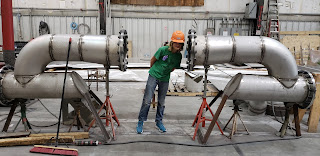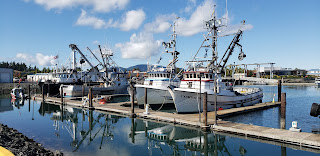From Peter:
Overall, we took about three months for our trip from SF to Alaska and back. We travelled just under 4000 miles at an average speed of 6.5 knots.
We ran the engine for 687.5 hours and burned 1385 gallons total for the trip. This gave us a burn rate of about 2 gallons per hour, though that includes trolling, docking, etc - our average fuel burn at 6.5-7kts was about 2.25 gallons per hour. Overall we got about 2.7 nautical miles to the gallon - not too bad for a 45 ton boat. The sails worked really well for stabilizing with winds in the teens or better and, in one measured test underway between Ketchikan and Meyers Chuck, cut our fuel consumption in half with steady 25 knot winds coming from an ideal direction. We need to work on the rigging though- it was hard to get proper trim sometimes with the headsail. Other than our little fuel solenoid glitch, our little ship ran flawlessly throughout the trip, and never let us down.
We brought a little Honda 2000EU generator just in case, but we found that our solar (along with charging from the engine alternator when underway) kept our house batteries topped off just fine, running the freezer, reefer, and all our other electrical needs.
The Spectra Cape Horn watermaker worked well throughout the cruise and gave us basically unlimited fresh water with very little maintenance required.
Anchor gear (120lb Rocna anchor and 300 feet of 3/8 G4 chain on a big Hydraulic winch) was completely reliable. We only failed to set once in heavy kelp - we were tired and not very patient. Otherwise our anchor set quick and never dragged. The deepest we anchored was in about 100ft of water (well protected anchorage in settled conditions), otherwise, most of our anchorages fell in the 40-70 ft range in clay/mud or sand/shells.
The Achilles dinghy with 15hp Tohatsu motor was a workhorse and served us well for exploring, fishing, provisioning, etc.
There were a few things that made this trip possible for us (and for which we are very grateful):
The generous "cruising policy" at our homeport of Galilee Harbor.
My work, which allowed me a summertime Leave of Absence.
Our boat, which was reliable and economical to operate, and which kept us safe and comfortable throughout our travels.
Sue's Dad for help at home with mail and other misc. unexpected things that popped up.
Our excellent crew for the long passages between SF Bay and Puget Sound!
Not sure what our next cruise will be (there are some logistics to workout before we head out for a longer trip than the one we just completed), but a short hop back down to the Channel Islands next summer is on our minds right now...
From Sue:
Not sure if it's harder to leave or come back - both take a lot of mental & physical effort. Been home for only a few days and already the trip seems a bit like a dream. Yesterday while being sandwiched in a muni car like a sardine (it was worth it to see the new Chase center) I had to close my eyes and conjure the open spaces and fresh air we took for granted all summer. There are some things that are harder: having to provision in different locations, laundromats (machines in various states of decay and crazy costs), timed showers, missing friends and family. But the positives outweigh all that. Discovering a beautiful anchorage, seeing a pod of dolphins or whales feed, meeting new friends on a friendly dock, taking a lovely hike through a pristine forest, looking at all the cool boats that surround you. You quickly find yourself falling into a daily routine that makes you ponder how you want to spend the rest of your time. For every one place you visit you learn about three others that sound interesting. We met many cruisers who go up every year to cruise around - we were asked numerous times if we would back in the Pacific NW next summer. Unfortunately the answer for next season is no, however in the coming years that will hopefully change.





















































